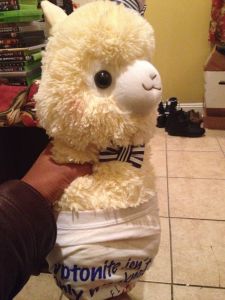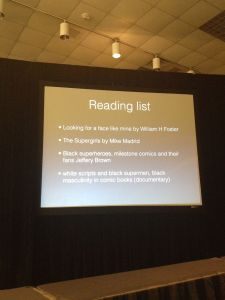by K. Hopson
Day 2 of Wizard World, y’all!
Saturday was, of course, the busiest day of the con. The place was SWAMPED with people. There was a healthy showing of cosplayers, and I’m happy to say that most of the panels were well-attended. Because it was so busy, there wasn’t much time for anything else, unfortunately. Ah well. I can find Alpaca plushies anywhere though … right?
I popped into three panels: “A Backstage Pass to LAIKA Animation Studio,” “Spotlight On Chris Claremont,” and (the one I was most excited about) “Civil Rights As Reflected In Comics.” I dropped into The “Backstage Pass” panel kind of late since one of my other panels turned out to be kind of boring.
LAIKA is the studio behind horrifying magic that was Coraline. They are planning to drop their latest movie, The Boxtrolls, this fall. Marketing and Brand Manager Mark Shapiro was in the middle of a discussion about the hows of stop-motion animation when I walked in. He also highlighted some of the key behind-the-scene players in the production of Coraline in a set of super-cute vignettes. Actually, the whole presentation was pretty adorable. He even handed around this nifty little puppet skeleton for the audience to handle.
After the vignettes, he took the time to answer some audience questions about type of background and material you would need to get a job in the industry. He said, in so many words, that studios are more concerned with an applicant’s ability to tell a good, flowing story (even with little means) than they are with fancy filmmaking skills. He also said that The Boxtrolls, will be much lighter than their previous works.
Oh, and about Mitch, the openly gay character from Paranorman? Sharpiro said, “We really support family values, and it’s just part of our culture.” So hooray for LAIKA, amiright?
Moving on to panel number two — Chris Claremont. FYI, for those who don’t know, this is the guy who is behind the creation of popular X-Men characters like Gambit, Mystique, and Jubilee. He apparently held the longest-ever writing stint at Marvel and created a bunch of cool storylines, like Days of Future Past and The Dark Phoenix Saga.
You know, I hate to say it, but Claremont was all over the place. He never actually answered any of the audience questions. It was more like he would take whatever subject the audience asked about and go on a ramble-rant for 15 minutes. Then he’d jump to another random topic. And this may be old news. I am not an expert in the comics scene.
But hey, you can’t say he isn’t interesting. Some ramble-rant highlights:
Explanation about why he doesn’t keep up with the current Marvel storylines:
“When I left back in ’10 and ’11, my presumption was that even though I was under contract, I was never gonna write for Marvel again. It was clear that the current editorial structure seemed to have no place for me and my work … their perception of how I write stories was not comfortable for them—they weren’t comfortable with me and I wasn’t comfortable with them.”
About random character age changes:
“Kitty [Pryde] is 16, and she was going to be 16 for the next 10 years because time moves differently in comics, and you have to pay attention to it because if a writer were to come along and say ‘It would be really cool if she could have a thing with Peter Wisdom. Of course she can’t do it if she’s 16, but even Peter’s not that twisted. I’d be that twisted, but it’s illegal. Right, so she’s 25.’ Okay, so explain to me how Kitty can be 25 the same year that Franklin is still 4 ½? It’s an integrated universe. You can’t muck about with this kind of stuff. Unfortunately, when you have a multiplicity of editors and writers, and no one’s paying attention to what’s going on…oops!”
About Psylocke’s race change:
“It’s all Jim Lee’s fault. When we were doing the three-parter, which was kind of his audition piece, I had this throw-away scene where Mojo just redesigns her. And she wakes up and she’s suddenly Asian. And, because it’s Mojo, not only is she Asian, nobody notices it’s a problem! Including her twin kid brother. And I figured, what the heck. We’ll fix it at the end of the story, because that’s what you do. Except she looked so cool … so we did it. And then I got fired. No, but it was one of those serendipitous, follow-your-instincts-and see-where-it-leads, but it turned out to be really really cool. Because even with purple hair, Betsy looked gorgeous. She was the best of the best. But she also looked pretty much like everybody else. And this was a way she didn’t look like everyone else. And that was intriguing.”
About characters having fun in comics:
“It should always have that sense of fun. The problem I have with a lot of comics from all off the companies is that nobody has a good time. I mean the characters don’t have a good time. I’m sorry, Kitty can walk through walls. Colossus can knock down buildings. Storm controls the weather, for crying out loud. Some of this should be fun, y’know?”
The “Civil Rights as Reflected in Comics” panel was very cool. Historian Thomas Strange, along with Immigrations and Customs Enforcement Special Agent Michael Manning (!), environmental scientist Tom Boucher, and a dude named Bill Klaus, explored some ground breaking civil liberty-related moments in comic book history and how it reflected what was happening during the time period. This was complete with a slide-show of the actual strips being discussed.
I should’ve asked the guy for a copy of the presentation. And yes, we all listened quietly as four white guys discussed diversity. But they actually did a pretty good job!
Strange was dressed as Luke Cage/Power Man sans afro. After taking some time to ask the audience’s opinion on the costume, he explained why he didn’t feel the afro was necessary to cosplay the character. Apparently, he got lambasted for the costume once after a posting a picture on the internet. And no, he didn’t do blackface:
“When I was a kid, I got a big stack of comic books from my uncle after my father passed away. It just so happened to be mostly Power Man, so I grew up thinking Power Man was the biggest superheroes in the Marvel universe. I do admit that if I’m not wearing the boots I just look like a white guy in a disco shirt. So the boots are important, but I don’t think the hair is.”
He went on to ask if anyone in the audience could think of any characters that absolutely required a skin color change to cosplay. I was surprised that there were no ignorant answers. Just Mystique, The Tick, and Purple Man. (And I didn’t even know who that was.)
This panel covered LGBT issues, race stigmas, interracial couples, POC characters, socio-economic status, immigration laws, the concept of Wonder Woman as a bondage fetish, and even the feminization of traditionally masculine costumes by some of the cosplay community. There was even a slide of suggested reading toward the end (pictured below) which I will be sure to check out later.
Visit Strange’s website, The Luke Cage Project, for more info. He’s also looking for panelists for the next go round. That’s a plug for all you nerds out there.




As a Psylocke fan who has wondered exactly why Betsy was popped into the body of an Asian woman like it was another costume… I’m facepalming especially hard over Claremont’s explanation that it was pretty much because they wanted to make her look “different” and not like everyone else. Just….. *FACEPALM*